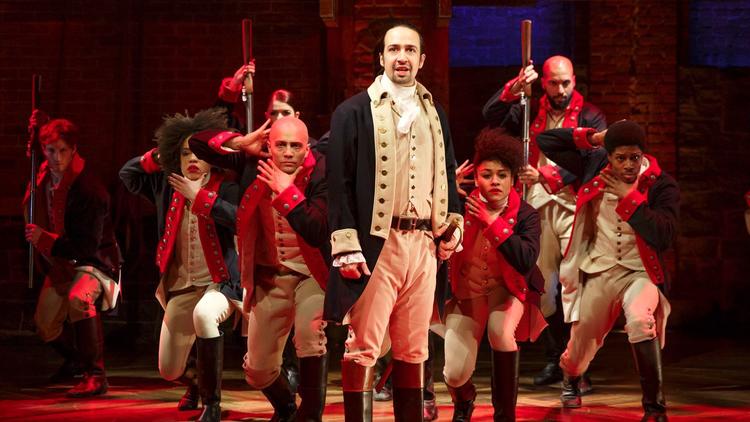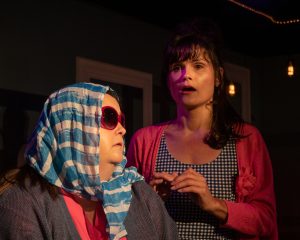San Diego Theater in 2018 Marked a Long 15 Years of a Disconcerting Trend
Out of question, Hamilton: An American Musical was the unutterably finest piece of theater to grace a local stage in 2018, or, for that matter, several seasons. Lin-Manuel Miranda’s nod to the enigmatic young Alexander, a Founding Father and the nation’s eventual first Treasury secretary, won 11 Tony Awards in 2016 (it was nominated for a record 16) and likely instigated a prevailing climate for musical theater to come — its obsession with verbiage and hip-hop timbre yielded a lush, brilliantly comprehensive oratory, and its production values literally surpassed themselves.
Absolutely first-rate in each and every respect (except one, and that’s a discussion for another time).

Lin-Manuel Miranda (center) wrote and played the title role in Broadway’s stupendous ‘Hamilton,’ the likes of which contemporary theater has never seen. Photo by Joan Marcus.
But as 2018 draws to a close, it occurs to me that those shows had one item in common: They were mounted at downtown’s Civic Theatre under the auspices of Broadway San Diego. That’s not my main concern, as Broadway San Diego is an essential agent for newsworthy big-budget work (it got us Hamilton, after all). But in the 15 years I’ve covered theater here, I’ve noticed a shift that’s becoming more prevalent all the time:
Local theater may be losing part of its grip as an art-intensive record of our life stories, with the demand for spectacle outpacing the thirst for relevance — by default.
Chicago, for my money the nation’s leader in theatrical enterprise, has about 220 companies, covering children’s groups through the professional and equity ranks. About 40 of the city’s venues seat fewer than 99 patrons — and that statistic is a stunning reflection of its breadth of theatrical appetite. The smaller the venue, the bigger the idea, I say — and while Chicago enjoys plenty of space for experimental and avant-garde new work, San Diego hosts only six venues of comparable size among about 100 companies countywide.
Six.
Germani . . . extracted the characters’ psychologies with deadly depth.
In the face of Chicago’s richness, it’s a mistake to think that local theater pales by comparison. I’ve seen plenty of small-venue garbage there, just as I’ve been outspokenly surprised by San Diego’s efforts to embrace the extranormal. It most notably came in the form of artistic director Al Germani’s Lynx Performance Theatre, whose thought-inducing pieces like The Exonerated (a nod to a group of Death Row inmates who saw their verdicts overturned) and Dickinson (an intimate look at the drivers behind legendary poet Emily) resonate some ten years after Germani opted to explore possibilities in film.
As often as not, you’d find these pieces in everything from a 45-seat Bay Park warehouse to a 35-chair hole in the wall behind a City Heights candy shop — and well more often than not, Germani (a mental health professional by trade) extracted the characters’ psychologies with deadly depth.
“From the plays we choose and the artists we employ to the beers we drink,” declared the literature from Triad Productions, “each decision we make is unified behind reaching that new generation of theatergoer.” Management meant every word, too — but without a second word, Triad left the scene before it established a sustainable presence.
Fritz Theatre, featuring the acclaimed Duane Daniels, late of TV. Doug Lay’s The Theatre, Inc., dug from under seven layers of tile and wallpaper in a 100-year-old downtown hotel. Sledgehammer Theatre, which mounted the finest production of August Strindberg’s A Dream Play I’ve ever seen. ion theatre company, still producing but at a greatly reduced pace. One thing or another has claimed or altered them, even as the press regularly covered them and as one (Sledge) had been a force here since 1985 (the company staged a brief reboot in 2014).

You can’t prove San Diego theater’s intellectual void by InnerMission Productions, which just staged Sarah Ruhl’s ‘Melancholy Play’ with considerable panache.
It’s the tiny little guys like that — the companies who unapologetically exploit the unlimited warp and woof within and beyond the human experience — that have borne the unpleasant brunt of what appears to be a slow redefinition of San Diego theater.
“People in San Diego like to laugh,” one acclaimed local director told me years ago for a story in another publication, “before they like to think.” It looks as though she’s right — and for every Hamilton that blesses our stages, her declaration foreshadows an equal and crippling curse.

Martin Jones Westlin, principal at editorial consultancy Words Are Not Enough and La Jolla Village News editor emeritus, has been a theater critic and editor/writer for 25 of his 47 years…
More…

Hamilton is considered a musical. My only exposure to it is what is on the page in the score. Take a look for yourself.